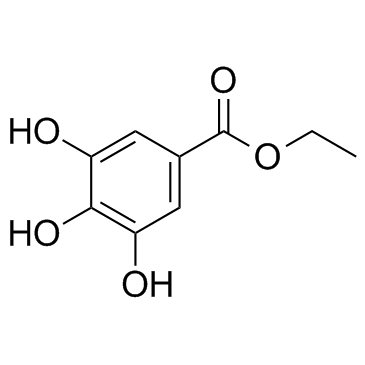Ethyl gallate

Ethyl gallate structure
|
Common Name | Ethyl gallate | ||
|---|---|---|---|---|
| CAS Number | 831-61-8 | Molecular Weight | 198.173 | |
| Density | 1.4±0.1 g/cm3 | Boiling Point | 447.3±40.0 °C at 760 mmHg | |
| Molecular Formula | C9H10O5 | Melting Point | 149-153 °C | |
| MSDS | Chinese USA | Flash Point | 185.0±20.8 °C | |
|
Antimicrobial activity of natural products from the flora of Northern Ontario, Canada.
Pharm. Biol. 53(6) , 800-6, (2015) The number of multidrug resistant (MDR) microorganisms is increasing and the antimicrobial resistance expressed by these pathogens is generating a rising global health crisis. In fact, there are only a few antimicrobial agents left that can be used against MD... |
|
|
Investigating the potential of under-utilised plants from the Asteraceae family as a source of natural antimicrobial and antioxidant extracts.
Food Chem. 161 , 79-86, (2014) Antimicrobial properties of ethanol and water extracts from eight Asteraceae species were investigated against three Gram positive (Staphylococcus aureus, MRSA and Bacillus cereus) and two Gram negative (Escherichia coli and Salmonella typhimurium) bacterial ... |
|
|
The tomato sauce making process affects the bioaccessibility and bioavailability of tomato phenolics: a pharmacokinetic study.
Food Chem. 173 , 864-72, (2014) Tomato sauce is the most commonly consumed processed tomato product worldwide, but very little is known about how the manufacturing process may affect the phenolic composition and bioavailability after consumption. In a prospective randomised, cross-over inte... |
|
|
Longitudinal Survey of Carotenoids in Human Milk from Urban Cohorts in China, Mexico, and the USA.
PLoS ONE 10 , e0127729, (2015) Emerging evidence indicates that carotenoids may have particular roles in infant nutrition and development, yet data on the profile and bioavailability of carotenoids from human milk remain sparse. Milk was longitudinally collected at 2, 4, 13, and 26 weeks p... |
|
|
Quantitative comparison of caffeoylquinic acids and flavonoids in Chrysanthemum morifolium flowers and their sulfur-fumigated products by three-channel liquid chromatography with electrochemical detection.
Chem. Pharm. Bull. 63(1) , 25-32, (2015) For the determination of seven caffeoylquinic acids [neochlorogenic acid (NcA), cryptochlorogenic acid (CcA), chlorogenic acid (CA), caffeic acid (CfA), isochlorogenic acid A (Ic A), isochlorogenic acid B (Ic B), isochlorogenic acid C (Ic C)] and two flavonoi... |
|
|
High performance liquid chromatography tandem mass spectrometry dual extraction method for identification of green tea catechin metabolites excreted in human urine.
J. Chromatogr. B. Analyt. Technol. Biomed. Life Sci. 972 , 29-37, (2014) The simultaneous analysis of free-form and conjugated flavonoids in the same sample is difficult but necessary to properly estimate their bioavailability. A method was developed to optimise the extraction of both free and conjugated forms of catechins and met... |
|
|
Chemical changes during fermentation of Abhayarishta and its standardization by HPLC-DAD.
Nat. Prod. Commun. 5(4) , 575-9, (2010) Abhayarishta is an Ayurvedic formulation prepared traditionally by the fermentation of the decoction of Terminalia chebula (pericarp), Vitis vinifera (fruits), Embelia ribes (fruits) and Madhuca indica (flowers). In the present communication, chemical changes... |
|
|
Quantitative analysis and anti-inflammatory effects of Gleditsia sinensis thorns in RAW 264.7 macrophages and HaCaT keratinocytes.
Mol. Med. Report. 12 , 4773-81, (2015) Gleditsia sinensis thorns have traditionally been used to treat edema and carbuncles and drain abscesses. In the present study, a simultaneous analysis of four flavonoids [(+)‑catechin, (‑)‑epicatechin, eriodictyol and quercetin] and two phenolic compounds (c... |
|
|
Validated HPLC method for the standardization of Phyllanthus niruri (herb and commercial extracts) using corilagin as a phytochemical marker.
Biomed. Chromatogr. 23(6) , 573-80, (2009) Phyllanthus niruri L., commonly known in Brazil as 'quebra-pedra', has long been used in the treatment of diverse diseases and especially urolithiasis. The therapeutic effects of P. niruri are attributed to various compounds present in the plant, including th... |
|
|
Neuroanatomy of the optic ganglia and central brain of the water flea Daphnia magna (Crustacea, Cladocera).
Cell Tissue Res. 363 , 649-77, (2016) We reveal the neuroanatomy of the optic ganglia and central brain in the water flea Daphnia magna by use of classical neuroanatomical techniques such as semi-thin sectioning and neuronal backfilling, as well as immunohistochemical markers for synapsins, vario... |